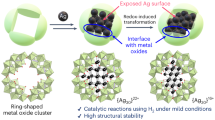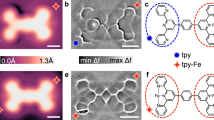Abstract
Transition metal oxides exhibit a rich collection of electronic properties and have many practical applications in areas such as catalysis and ultra-high-density magnetic data storage. Therefore the development of switchable molecular transition metal oxides has potential for the engineering of single-molecule devices and nanoscale electronics. At present, the electronic properties of transition metal oxides can only be tailored through the irreversible introduction of dopant ions, modifying the electronic structure by either injecting electrons or core holes. Here we show that a molybdenum(VI) oxide ‘polyoxometalate’ molecular nanocluster containing two embedded redox agents is activated by a metallic surface and can reversibly interconvert between two electronic states. Upon thermal activation two electrons are ejected from the active sulphite anions and delocalized over the metal oxide cluster cage, switching it from a fully oxidized state to a two-electron reduced state along with the concomitant formation of an S–S bonding interaction between the two sulphur centres inside the cluster shell.
This is a preview of subscription content, access via your institution
Access options
Subscribe to this journal
Receive 12 print issues and online access
$259.00 per year
only $21.58 per issue
Buy this article
- Purchase on Springer Link
- Instant access to full article PDF
Prices may be subject to local taxes which are calculated during checkout





Similar content being viewed by others
References
Long, D.-L., Burkholder, E. & Cronin, L. Polyoxometalate clusters, nanostructures and materials: From self assembly to designer materials and devices. Chem. Soc. Rev. 36, 105–121 (2007).
Müller, A., Shah, S. Q. N., Bögge, H. & Schmidtmann, M. Molecular growth from a Mo176 to a Mo248 cluster. Nature 397, 48–50 (1999).
Rhule, J. T. et al. Stable, self-assembling, equilibrating catalysts for green chemistry. J. Am. Chem. Soc. 123, 12101–12102 (2001).
Long, D.-L. & Cronin, L. Towards polyoxometalate-integrated nano systems. Chem. Eur. J. 12, 3698–3706 (2006).
Song, Y.-F. et al. Design of hydrophobic polyoxometalate hybrid assemblies beyond surfactant encapsulation. Chem. Eur. J. 14, 2349–2354 (2008).
Song, Y.-F., Long, D.-L. & Cronin, L. Non covalently connected frameworks with nanoscale channels assembled from a tethered polyoxometalate–pyrene hybrid. Angew. Chem. Int. Edn 46, 3900–3904 (2007).
Song, Y.-F. et al. From polyoxometalate building blocks to polymers and materials: The silver connection. J. Mater Chem. 17, 1903–1908 (2007).
Long, D.-L., Streb, C., Song, Y.-F., Mitchell, S. & Cronin, L. Unravelling the complexities of polyoxometalates in solution using mass spectrometry: Protonation versus heteroatom inclusion. J. Am. Chem. Soc. 130, 1830–1832 (2008).
Long, D.-L., Kögerler, P. & Cronin, L. Old clusters with new tricks: Engineering S···S interactions and novel physical properties in sulphite-based Dawson clusters. Angew. Chem. Int. Edn 43, 1817–1820 (2004).
Lewis, P. A. et al. Molecular engineering of the polarity and interactions of molecular electronic switches. J. Am. Chem. Soc. 127, 17421–17426 (2005).
Long, D.-L., Abbas, H., Kögerler, P. & Cronin, L. Confined electron-transfer reactions within a molecular metal oxide ‘Trojan Horse’. Angew. Chem. Int. Edn 44, 3415–3419 (2005).
Baffert, C. et al. Experimental and theoretical investigations of the sulfite-based polyoxometalate cluster redox series: α- and β-[Mo18O54(SO3)2]4−/5−/6−. Chem. Eur. J. 33, 8472–8433 (2006).
Badjić, J. D., Balzani, V., Credi, A., Silvi, S. & Stoddart, J. F. A molecular elevator. Science 303, 1845–1849 (2004).
Song, I. K., Kaba, M. S. & Barteau, M. A., Nanoscale investigation of mixed arrays of Keggin-type and Wells–Dawson-type heteropolyacids (HPAs) by scanning tunnelling microscopy (STM). Langmuir 18, 2358–2362 (2002).
Dhanak, V. R., Robinson, A. W., van der Laan, G. & Thornton, G. Beamline 4: A dedicated surface science facility at Daresbury Laboratory. Rev. Sci. Instrum. 63, 1342–1345 (1992).
Werfel, F. & Minni, E. Photoemission study of the electronic structure of Mo and Mo oxides. J. Phys. C 16, 6091–6100 (1983).
Mo(V) has a characteristic binding energy of 230.7 eV. Available at NIST Photoelectron spectroscopy database: http://srdata.nist.gov/xps/.
Tokarz-Sobieraj, R. et al. Properties of oxygen sites at the MoO3(010) surface: Density functional theory cluster studies and photoemission experiments. Surf. Sci. 489, 107–125 (2001).
Audi, A. A. & Sherwood, P. M. A. X-ray photoelectron spectroscopic studies of sulfates and bisulfates interpreted by Xα and band structure calculations. Surf. Interface Anal. 29, 265–275 (2000).
Adler, D. Mechanisms for metal-non metal transitions in transition-metal oxides and sulfides. Rev. Mod. Phys. 40, 714–736 (1968).
Kuhn, N. & Anson, F. C. Adsorption of monolayers of {P2Mo18O62}6− and deposition of multiple layers of {Os(bpy)3}2+ − {P2Mo18O62}6− on electrode surfaces. Langmuir 12, 4008–4014 (1996).
Imada, M., Fujimori, A. & Tokura, Y. Metal–insulator transitions. Rev. Mod. Phys. 70, 1039–1263 (1998).
Rohmer, M. M. & Bénard, M. Bond-stretch isomerism in strained inorganic molecules and in transition metal complexes: A revival? Chem. Soc. Rev. 30, 340–354 (2001).
Lehmann, J., Gaita-Arino, A., Coronado, E. & Loss, D. Spin qubits with electrically gated polyoxometalate molecules. Nature Nanotech. 2, 312–317 (2007).
Acknowledgements
The authors would like to thank the Leverhulme Trust (London), the Royal Society, the University of Glasgow, WestCHEM and the Engineering and Physical Sciences Research Council (UK) for funding.
Author information
Authors and Affiliations
Contributions
L.C. and M.K. conceived and designed the experiments, D.L. synthesized the clusters and N.G., N.M. and J.J. prepared the samples for the photoemission studies. C.F. and J.J. performed the experiments, M.K., C.F. and J.J. analysed the photoemission data, and N.B. and V.D. helped with the synchrotron experiments. P.K. performed the theoretical calculations. M.K. and L.C. co-wrote the paper.
Corresponding authors
Supplementary information
Rights and permissions
About this article
Cite this article
Fleming, C., Long, DL., McMillan, N. et al. Reversible electron-transfer reactions within a nanoscale metal oxide cage mediated by metallic substrates. Nature Nanotech 3, 229–233 (2008). https://doi.org/10.1038/nnano.2008.66
Received:
Accepted:
Published:
Issue Date:
DOI: https://doi.org/10.1038/nnano.2008.66
This article is cited by
-
Synthesis of Polyoxometalates-Dianhydrides Based Polyimides for Photocurrent Generation: A Combined Experimental and Computational Study
Journal of Cluster Science (2024)
-
Design and fabrication of memory devices based on nanoscale polyoxometalate clusters
Nature (2014)
-
Gas-Phase Synthesis of Singly and Multiply Charged Polyoxovanadate Anions Employing Electrospray Ionization and Collision Induced Dissociation
Journal of the American Society for Mass Spectrometry (2013)
-
Preparation of monolayers of [MnIII 6CrIII]3+ single-molecule magnets on HOPG, mica and silicon surfaces and characterization by means of non-contact AFM
Nanoscale Research Letters (2011)



